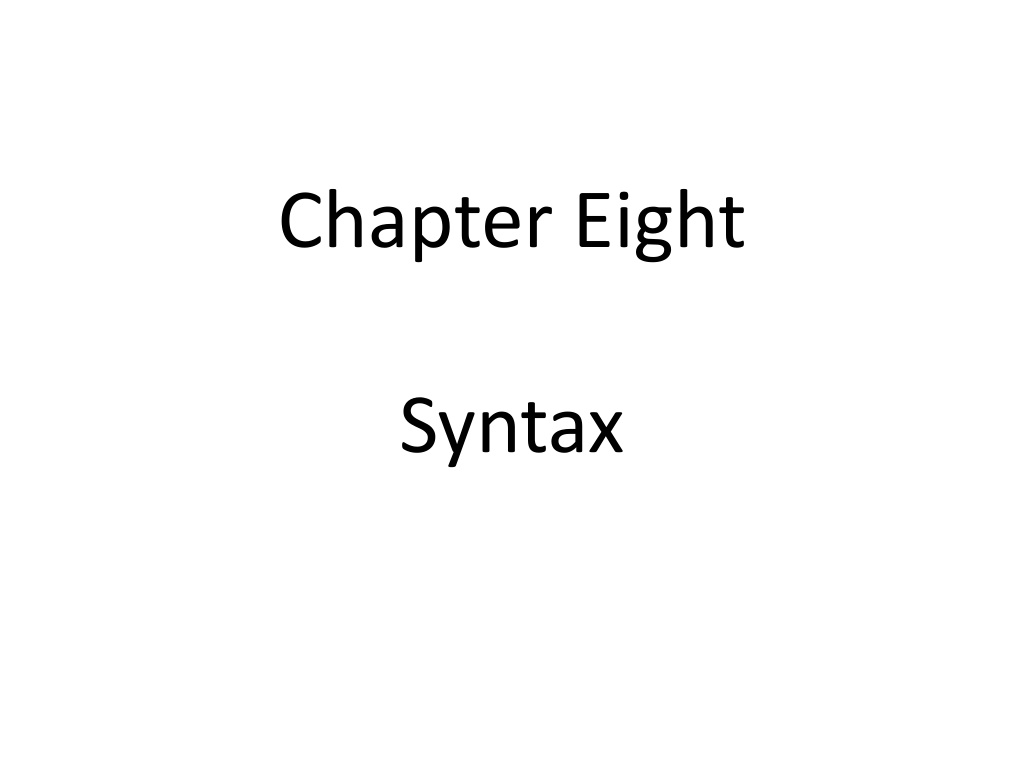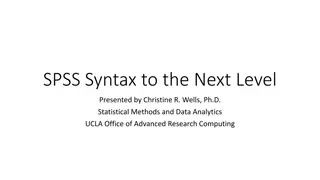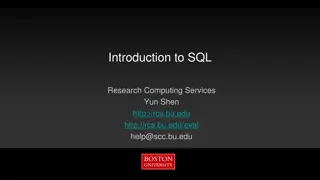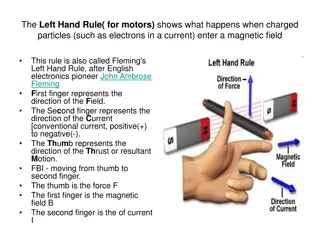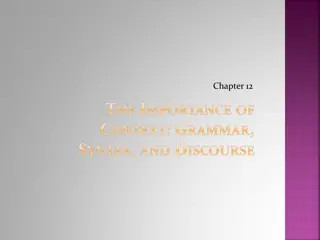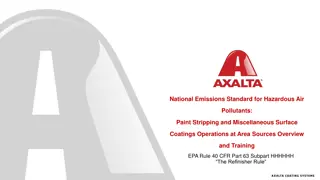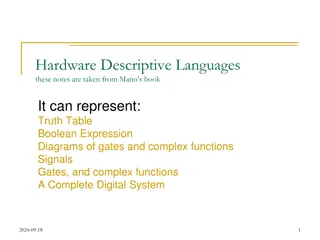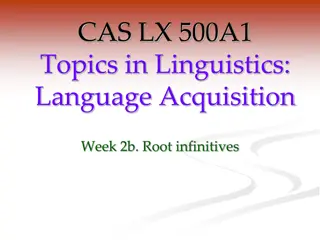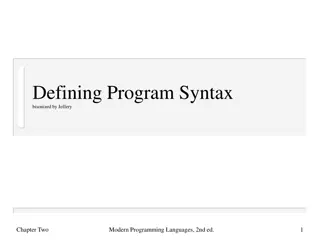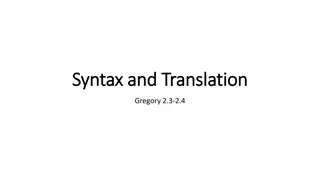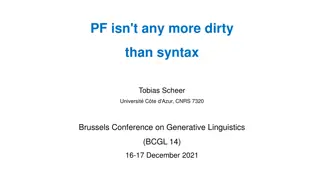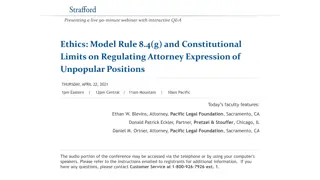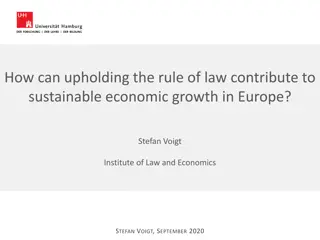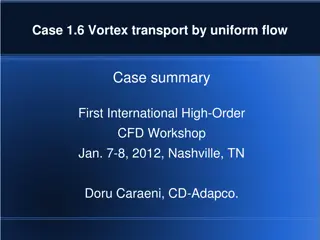Syntax in Language Study: Order and Rule Systems
Syntax in language study focuses on the structure and order of components within a sentence, delving into the underlying rule systems used to generate correct structures. Explore deep vs. surface structures, structural ambiguity, and the concept of generative grammar in syntactic analysis.
Download Presentation

Please find below an Image/Link to download the presentation.
The content on the website is provided AS IS for your information and personal use only. It may not be sold, licensed, or shared on other websites without obtaining consent from the author.If you encounter any issues during the download, it is possible that the publisher has removed the file from their server.
You are allowed to download the files provided on this website for personal or commercial use, subject to the condition that they are used lawfully. All files are the property of their respective owners.
The content on the website is provided AS IS for your information and personal use only. It may not be sold, licensed, or shared on other websites without obtaining consent from the author.
E N D
Presentation Transcript
Chapter Eight Syntax
Syntax When we concentrate on the structure and order of components within a sentence we are studying the syntax of a language. Syntax (from Greek) = putting together In early approaches to syntax, there was a focus on the description of the ordering of elements in the linear structure of the sentence. Recently, the focus shifted to the underlying rule system that we use to produce or generate sentences.
In syntax, we focus on the all and only criterion./ i.e. when analyzing any language, we account for all grammatically correct structures and only those structures. We have to check that any proposed grammatical rule has to produce only correct structures. E.g. to form a prepositional phrase we put a preposition before a noun near London , however, if we apply this rule to all prepositions and nouns we will produce incorrect phrases like near tree or with dog What s a noun phrase? The revised definition (an article plus a noun/ a proper noun/ or a pronoun) Therefore, the rule can be fixed to say a prepositional phrase in English consists of a preposition followed by a noun phrase / so the revised rule can produce well-formed structures near the tree and with the dog or with you
Generative grammar: the small and finite set of rules that are capable of producing a large and infinite number of well-formed structures. It is one of the goals of syntactic analysis. its called generative because it can be used to generate or produce sentence structures and not just describe them. This type of grammar reveals two phenomena: 1/ how some sentences can appear different on the surface but they are actually closely related. 2/ how some sentences can appear similar on the surface but they are in fact different.
Deep and Surface Structure Two different sentences Charlie broke the window. (active) The window was broken by Charlie. (passive) The difference is in their surface structure However, both share the underlying structure (NP V NP)/ they are almost identical in their deep structure which is an abstract (unseen) level of structural organization. Thus, grammar must be capable of showing how a single underlying structure can become different surface structures.
Structural Ambiguity E.g. Annie bumped into a man with an umbrella. I once shot an elephant in my pajamas. Small boys and girls. They have two underlying interpretations with the same surface structure. Syntactic analysis has to be capable of showing the structural distinction between these underlying representations.
Recursion Recursion: Repeatable any number of times. Grammar rules have to have the capacity to be applied more than once in generating a structure. E.g. The gun was on the table near the window in the bedroom (we are repeating the rule of forming prepositional phrases) Also grammar has to have the ability to put sentences inside other sentences. E.g., John believed that Cathy knew that Mary helped George.
Tree diagrams One of the most common ways to create a visual representation of syntactic structure Uses symbols (e.g., N= noun, NP= noun phrase) It captures the hierarchal organization of the underlying structures of phrases and sentences/ shows clearly that there are different levels in the analysis E.g. The girl saw a dog (see pgs. 99- 100)
Symbols used in Syntactic Analysis Most common symbols used in syntactic categories: S / N/ V/ Art/ NP/ VP/ Adj/ Pro/ PN/ Adv/ Prep/ PP (see p. 101) Three new symbols: 1- ( ) means consists of or rewrites as e.g., NP Art N The dog 2- round brackets ( ) means an optional constituent - e.g. NP Art (Adj) N - The (small) dog. 3- curly brackets { } means only one of the elements can be selected/ instead of writing three separate rules I can join them in one rule: - e.g. NP { Art N, Pro, PN} - the dog, it, Cathy (See p. 101 for the full list)
Phrase Structure Rules When we use a tree diagram we can think of it in two different ways: Static, a fixed representation of the structure of the sentence that is written in the bottom of the diagram Dynamic , it represents a way of generating not only that one sentence, but a large number of sentences with similar structures This is more appealing because it enables us to generate a very large number of sentences with a small number of rules. These rules are called:
Phrase structure rules: rules that state that the structure of a phrase of a specific type will consist of one or more constituents in a particular order. i.e., these rules represent the underlying or deep structure of sentences in English. We can use these rules to present the information of a tree diagram in another format, e.g., NP Art N S NP VP It means a sentence rewrites as (consists of) a noun phrase and a verb phrase NP {Art (Adj) N, Pro, PN} VP V NP (PP) (Adv) Adam broke the window near the shop aggressively. PP Prep NP Near London
Lexical rules Lexical rules: they specify which words can be used when we rewrite constituents, e.g., PN {Mary, George} It means a proper noun rewrites as (consist of) Mary or George N {girl, dog, boy} Art {a, the} Pro {it, you} V {followed, helped, saw} we can rely on these rules to generate grammatically correct sentences, e.g., A dog followed the boy. Mary helped George. (See p.103) notice sentences (1-6) all follow the structure (NP V NP) while (7-12) have different incorrect structures
As a way of visualizing how the phrase structure rules form the basis of these sentences we can draw them into tree diagrams and add to them the sentences (on the bottom of the diagram) (see p. 103)
Movement Rules The simple phrase structure rules taken so far help in generating sentences in a fixed order (declarative forms/ statements) however, they cannot be used to make questions (interrogative forms) In order to make a question we have to move one part of the structure to a different position. This process is called a movement rule. E.g., You will help Mary. Will you help Mary?
Therefore, we have to expand the phrase structure rule to include an auxiliary verb (Aux) as part of the sentence. S NP Aux VP (a phrase structure rule) Aux {can, could, should, will, would} (a lexical rule) V {follow, help, see} (a lexical rule) Now we can use these components to specify a movement rule that we can use to describe the structure of one type of questions (notice the use of a special arrow symbol) NP Aux VP Aux NP VP (a movement rule) This type of rule can be also illustrated by a two tree diagrams (see p.104) Using the same rules we can also generate other questions (see p. 105) they all have different surface structures with the same underlying deep structure.
Back to recursion The phrase structure rules taken so far do not have recursive elements. As mentioned earlier, in correct grammar, we have to be able to include sentences within sentences E.g., John believed that [Cathy knew that [Mary helped George]]. we notice that after the verbs believe and know, the word that is used to connect it to the following sentence
Complement phrases: The word that is called a complementizer (C). The role of it is to introduce a complement phrases (CP) E.g., [that Mary helped George] (CP) Mary helped George. (S) So we can identify CP as follows: a complent phrase rewrites as a complementizer and a sentence, CP C S
We can also notice from the example that the CP [ that Mary helped George] came after the verb knew. This means we are using the (CP) as part of the verb phrase (VP) Thus we can write another rule that says that a verb phrase rewrites as a verb and a complement phrase VP V CP
Now, if we add these two new rules to two earlier rules we have taken before, we can see how recursion is applied in grammar: S NP VP VP V CP CP C S This means we can use these rules to create an endless sentence containing other sentences. Its shown best through tree diagrams (See p. 106)
